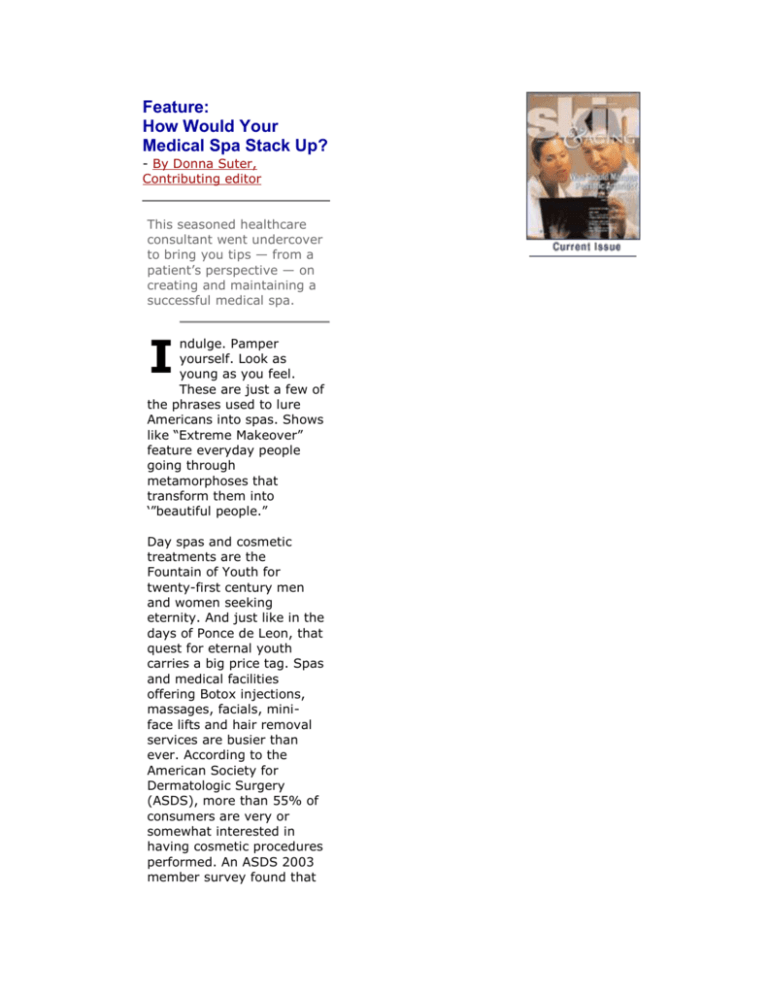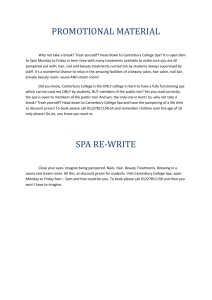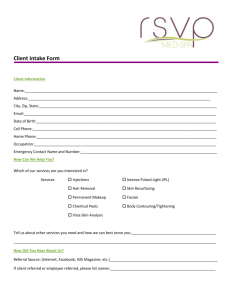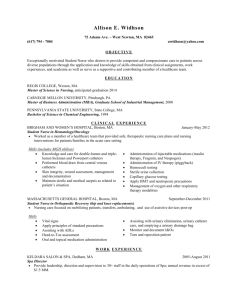medicalspa
advertisement

Feature: How Would Your Medical Spa Stack Up? - By Donna Suter, Contributing editor This seasoned healthcare consultant went undercover to bring you tips — from a patient’s perspective — on creating and maintaining a successful medical spa. I ndulge. Pamper yourself. Look as young as you feel. These are just a few of the phrases used to lure Americans into spas. Shows like “Extreme Makeover” feature everyday people going through metamorphoses that transform them into ‘”beautiful people.” Day spas and cosmetic treatments are the Fountain of Youth for twenty-first century men and women seeking eternity. And just like in the days of Ponce de Leon, that quest for eternal youth carries a big price tag. Spas and medical facilities offering Botox injections, massages, facials, miniface lifts and hair removal services are busier than ever. According to the American Society for Dermatologic Surgery (ASDS), more than 55% of consumers are very or somewhat interested in having cosmetic procedures performed. An ASDS 2003 member survey found that the greatest relative increases from 2001 to 2003 were in non-ablative skin rejuvenation (up 60%), Botox therapy (up 47%) and soft tissue augmentation (up 36%). According to the American Society of Plastic Surgeons, the top five non-surgical cosmetic procedures in 2002 were Botox injection (1,123,510), chemical peel (920,340), microdermabrasion (900,912), laser hair removal (587,540) and sclerotherapy (511,827). Some consumer research claims that men and women spend more on skincare products, spa treatments and cosmetic procedures than they do on routine health care, dental care and primary eye health care combined. How can you successfully be a part of this evergrowing trend? As a marketing expert specializing in the healthcare sector, I recommend that you never forget the importance of shaping the patient’s perception of service quality. Quality Control Every business, regardless of what it sells or of its size, has a reputation for the quality of goods and services it delivers. What quality do you associate with Disney, Ritz Carlton and Federal Express? Pretty high, right? Now, what quality of service do you associate with your local water company, electric company or the post office? Chances are you rated this group lower. It’s not that the second group fails to give good service. In fact, they give excellent service for a very reasonable price. Think about it. You can drop a letter into any corner mailbox and send it anywhere in the country for the price of a stamp. What would you rather give up for one month: Disney or electricity? Why do companies like Federal Express have such an excellent reputation? One key reason is that they do, in fact, give excellent service. But another equally important reason is that they have learned the subtle art of shaping customers’ perception of that service. Perception is how we interpret what we experience. Disney and the Ritz have learned that perceived service quality is the difference between what the customer gets and what they expect. Your interpretation of what you see and hear is personal opinion. When it comes to winning and keeping medical spa patients, it’s the patient’s opinion of the quality of service that determines how successful a medical spa will be. Every patient comes into your facility with certain expectations about quality — your medical spa’s goods, service and the total experience of interacting with your staff and the convenience of the entire process. When you exceed those expectations, the patient perceives the quality as relatively high. When you fail to meet his or her expectations he or she perceives the quality as relatively low. In the back of every patient’s mind is a scale that compares what he or she gets with what he or she expected. And the more it comes up on the plus side, the greater the perceived quality of your spa services will be. Perception Meets Reality A client of mine on the West Coast had just put in a medical spa and asked me to evaluate the staff and the facility from the patient’s point of view — without the staff’s knowledge that I was evaluating them or the facility. As a practice management consultant with 15 years of experience and a selfdiagnosed addiction to indulging in spa treatments wherever my travels find me, my doctor/client felt I’d be able to give valuable feedback on what a woman seeking spa services expects. I went undercover, and I booked an appointment and underwent treatment just as any other patient would — the staff didn’t know who I was. Sadly, on a scale of 1 to 10, I rated my client a 4. Why? Because, right or wrong, I compared my medical spa experience with my day spa experiences and what I’d seen on television. My client’s facility was lacking. Was I comparing apples to apples? No. Was I reacting like an ordinary patient wanting to spend his or her discretionary dollar on medical spa treatments? Definitely, yes. It all Starts With a Phone Call “Hi, I saw your ad in the paper and want to know more about microdermabrasion.” Marcia, who has a great phone voice, answered the clinic phone and replied. “No one is here who can answer that question. Do you want to leave a message or can I put you through to voicemail?” When I asked if I could just make an appointment, again, I was disappointed. “They keep their own appointment book.” I wasn’t impressed. Patients seeking to indulge in a spa treatment don’t want to call back. We all tend to over-book schedules and once we’ve decided to finally do something about our looks, we want immediate gratification. It’s much easier to call the next spa in the Yellow Pages or flip to the next ad in the paper than it is to remember to call back. Think of it this way, you’re asking someone willing to spend more than $100 on selfindulgence to call back when there is no one who routinely answers your practice’s phone who can field even the simplest of questions about your spa treatments? In marketing terms, this is called sending mixed messages. Your advertisement, brochure and Yellow Page ad scream luxury and class, but the telephone handler doesn’t live up to the expectation. Recommendation: Make up script cards for the front desk personnel that give the name of the treatment, a consumer-friendly, nonmedical mumbo-jumbo description and end with an offer to book an appointment. Ms. Suter, I can make that appointment for you now. Is a morning or afternoon time best for you? The Waiting Area After finally booking my appointment, on a hot summer day, I was escorted to a private waiting area furnished with an off-white, teal and burgundy sofa and matching small loveseat — unfortunately, the fabric colors and weave were popular about 10 years ago. The framed prints on the walls didn’t really go with the furnishings. A dated-looking glass display case with shelves draped in glittering gold fabric filled with skincare lotions and creams sat across from the loveseat. On top of this display case sat the upper torso of a manikin wearing an unkempt wig, sunglasses, a winterlooking long-sleeved blouse and a black dressy oblong scarf. Because there was no music, I could hear the spa consultant talking on the telephone in the next room. Take a visual inventory of your medical spa. Does the patient see a clean, neat, professional operation or one that is furnished with hand-me-downs? Does it look poorly maintained? Does it look like a place that someone could spend hundreds of dollars on quality beauty-enhancing treatments using top-ofthe-line products and stateof-the-art equipment? Or, does it look like a place where only second-class treatments can be bought? The interior of your medical spa immediately confirms or denies that the patient has made the right choice. What this means to you is that your medical spa must have at least a small portion of the style found in abundance at day-spa facilities. Will you choose to decorate your reception area with period antiques? How about ‘Pier One’ modern? Or is European minimalist with lots of polished wood more your idea of luxury? How about staff attire? Should they dress all in black? What about a tailored white lab coat over retail dress? Recommendation: Unspoken messages can be louder than words. About 85% of what we remember comes through our eyes. Have you ever noticed how clean Disney World is? It’s no accident. Rather, it’s a subtle way of telling the customer, “We take pride in our work.” The Treatment Room My first treatment was microdermabrasion. To protect my clothes from splatter, the consultant suggested that I remove my blouse and put on a smock. When I asked where I could put my purse and clothing, she moved some supplies from the counter and indicated they could be placed there. When she left the room, I surveyed the surroundings. I caught the faint smell of some type of cleaning agent. A small boom-boxtype radio sat on the floor in the corner. Supplies cluttered the counter. There was no mirror. When she returned, I sat in the treatment chair. She closed the door and tilted it into a prone position. My 5’7” frame was too long for the chair. (I was lying with my feet sticking over the footrest.) About halfway through the treatment, a coworker knocked on the door. In order to open the door, I had to move my feet. She interrupted my appointment to tell my spa consultant that she was wanted on the telephone. By the time the treatment was over, the small of my back hurt from the awkward angle in which the chair had placed me. Recommendation: Patients don’t know how to objectively evaluate the quality of spa treatments and tend to make judgments based on subjective measures or feelings. The comfort of your office motivates patients to return again and again. For example, nonmedical spas have finger food in the waiting area; offer guests bottled water when checking in and provide lockers for clothes. Even small massage studios provide a nice table or a shelf for the guest’s personal belongings and ‘relax’ the customer with soft music and fill the air with a pleasant scent. Other than my visit to this medical spa, I’ve never had the individual administering my treatment interrupted by a person delivering a message. All the previous spas I’d visited seated me in luxurious, over-sized chairs that reclined. There were adjustable features that contoured to my length and ensured exquisite comfort. The Treatment Because the doctor wanted me to observe two groups of spa staff, he asked that I select to have a microdermabrasion on day one and return the next day for a photorejuvenation treatment. I had never requested these treatments before and was a bit nervous. Would it hurt? Would I leave with a red face? Personnel were extremely helpful and obviously knew their products and treatments well. However, they assumed that I knew more about the skin treatments I had selected than I actually did. For example, the person who administered the microdermabrasion treatment said that it would feel like a cat licking my face. (It didn’t.) I would have enjoyed the treatment more if she had shown me the equipment prior to the treatment and demonstrated the feel of it on the inside of my wrist. The day I had the photorejuvenation treatment was even scarier. Even though I knew the treatment involved a laser, I wasn’t prepared for the popping sounds or the flashes of light produced by the laser. In fact, even though I was told that as long as I kept my eyes closed, they were protected, I didn’t completely believe it. As I was being treated, I imagined that a poorly aimed laser beam would permanently blind me. (When I later expressed my fears, I was then shown the metal shields that had been placed on top of the gaze covering my eyes.) Recommendation: When communicating with the patient, it’s important to remember that the experience is very novel to him or her. Patient Perceptions What is the marketing lesson that my experience illustrates? Even a very knowledgeable patient doesn’t really know what to expect. It’s the medical spa’s responsibility to educate and then to repeat again and again what is taking place and reassure the patient that everything is proceeding as normal and that no harm will come to him or her. Why is this so important to understand? It’s important because in the end, the patient’s perceived quality is the single most important factor in determining longterm profitability. That conclusion was reached by the Strategic Planning Institute (SPI) of Cambridge, MA, after testing thousands of variables in numerous businesses to determine what impact various strategies have on longterm profitability. After assembling an extensive database and doing a lot of hard research, they came to the obvious conclusion that you win and keep customers by giving them a good deal for their money, as they perceive it. In addition, the SPI study found that businesses that rated low on service averaged a meager 1% return on sales and lost market share at a rate of 2% per year. On the other hand, companies that scored high in service averaged a 12% return on sales, gained market share at the rate of 6% per year, and charged significantly higher prices. So how can you make the patient aware of the good deal they’re getting for coming to you? The final measure of quality is simply how the patient perceives it. It’s as simple as making sure that your physical plant complements your commitment to quality and that personnel understand that even a very educated consumer may be frightened while undergoing what the staff considers to be a routine enhancement procedure. Now for the big question: What causes patients to perceive service as good or bad? It’s not just one thing, but many. Image is important; but how your staff communicates with patients is even more important. When there is a breakdown in the communication process, perception goes back to image. Furthermore, an informed patient feels more in control and on top of the situation, which in turn makes the patient more comfortable. Meeting Patient Needs If you have a medical spa and wish to successfully market it, you must remember that you must first define the need (your patients’, not yours). Defining that need and communicating your ability to meet that need are crucial factors in successful marketing. Are you meeting the needs and expectations of your patients? Unless you regularly survey your patients, you can’t know. This task can be accomplished in the form of telephone conversations, focus groups and written surveys. You’ll likely be pleased with the candor, honesty and helpfulness of your patients. Satisfied patients are very loyal and genuinely interested in the success of the practice. A wealth of psychographic information can also be gained from these written and telephone patient surveys. Be sure to leave space for comments so patients can elaborate on their opinions. Marketing Your Spa Your unique selling points (USPs) are the ‘buzz’ words and phrases — ‘bullets’ in your printed material — that patients will use to form their opinions of your practice and differentiate you from your competition. Patients will form opinions whether you give these to them or not, based on word of mouth and competitors’ advertising. Your USPs, in the minds of your prospective patients, are the most professional disqualitative (taking your competition out of the picture) marketing edge money can buy. The challenge is putting your creative USPs to work for your businesses by incorporating them into marketing messages that make sense to your target market. While medical spas may appear similar on the surface, USPs differ greatly. Remember, marketing means that you are setting yourself apart from hair salons with spas, general dermatology practices and resort spas — not just other medical spas. Once you locate the right patients and train your staff to meet their needs, they will reward your efforts by bringing their friends, family and business associates to your door. Willing to pay for quality and service, these profitable patients also give you freedom and control over your spa in addition to increased revenue. Skin & Aging - ISSN: 10960120 - Volume 11 - Issue 10 - October 2003 - Pages: 106 - 109 Reprints/Permissions | Privacy Policy/Copyright | Contact Us © 2006 HMP Communications







